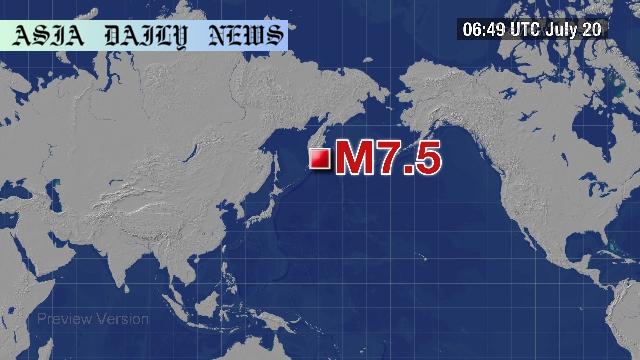Earthquake: A magnitude 7.5 earthquake struck off the east coast of Russia’s Kamchatka Peninsula at 6:49 a.m. UTC on Sunday.

Introduction to the Earthquake in Kamchatka
A powerful 7.5 magnitude earthquake struck off the eastern coast of Russia’s Kamchatka Peninsula at 6:49 a.m. UTC on Sunday. This seismic event is one of significant concern due to its potential impact on the surrounding regions, as well as its occurrence in a geologically active area. The region is known for its tectonic activity, situated as it is along the Pacific Ring of Fire, a hotspot for earthquakes and volcanic eruptions.
Earlier, at 6:30 a.m. UTC, the same area experienced a magnitude 7.0 earthquake that likely served as a precursor to the larger event. The Pacific Tsunami Warning Center in Hawaii issued a tsunami alert shortly after the second quake, notifying nearby nations, including Japan, of the potential risk of tidal changes. Although authorities have stated that no significant damage is anticipated, the situation highlights the ever-present threat of natural disasters in tectonic regions.
Global Context: The Pacific Ring of Fire
The Kamchatka Peninsula is an integral part of the Pacific Ring of Fire, a geological region encircling the Pacific Ocean, renowned for frequent seismic and volcanic activities. The frequent earthquakes in this region are caused by the collision and subduction of tectonic plates. The Pacific plate’s constant movement against the Eurasian plate creates immense pressure beneath the earth’s surface, resulting in periodic catastrophic events.
Historically, this region has endured significant seismic episodes. In 1952, a massive 9.0 magnitude earthquake struck near Kamchatka, generating one of the most destructive tsunamis of the 20th century. While advancements in monitoring and warning systems have dramatically improved over the years, the recurrence of such powerful quakes reiterates the vulnerability of coastal areas along the Pacific Rim.
The Role of Tsunami Alerts and Responses
Following the 7.5 magnitude earthquake, the Pacific Tsunami Warning Center issued alerts, a crucial step in mitigating potential fatalities from seismic ocean waves. The alert mechanism often includes monitoring tidal waves and notifying regions at risk, giving residents time to evacuate and prepare. Japan’s Meteorological Agency was also quick to evaluate the situation, advising against panic but urging vigilance along coastal areas.
While tsunami alerts are critical in such incidents, the challenge lies in accurately predicting the scale and reach of the oceanic impact. Tsunami waves often vary in magnitude depending on underwater topography, distance from the epicenter, and seismic force. However, recent incidents demonstrate that preparedness and swift communication are vital in reducing loss of life and infrastructure damage.
Conclusion and Preparedness Measures
This latest earthquake off the Kamchatka Peninsula serves as a reminder of the planet’s dynamic nature and the unpredictable forces shaping it. For nations situated on or near tectonic boundaries, constant vigilance and preparedness remain critical. Enhanced monitoring technology, combined with well-rehearsed evacuation strategies, can make a tremendous difference in managing the aftermath of such disasters.
As the Pacific Ring of Fire continues to show its power, international collaboration in tracking seismic activity and sharing real-time data has become indispensable. Such synergy not only minimizes risks but also ensures collective resilience against the challenges posed by nature. With the lessons learned from past experiences, governments and communities alike must strive to adapt and prepare for the ever-present possibility of further seismic events.
Commentary
The Broader Implications of Kamchatka’s Earthquake
Earthquakes are a vivid reminder of the earth’s untamed power. The recent magnitude 7.5 earthquake near the Kamchatka Peninsula underscores this reality, evoking both alarm and awe. Located within the Pacific Ring of Fire, Kamchatka is no stranger to seismic disturbances, yet each new event prompts reflection on humanity’s continual struggle to coexist with nature’s unpredictability.
The Importance of Monitoring and Preparedness
Events like these serve as a test of global disaster preparedness systems. The prompt issuance of tsunami warnings demonstrates how far we’ve come in leveraging technology to address natural threats. However, the quake also highlights the constant need for improvements, especially in developing coastal regions that may lack adequate infrastructure to withstand such events. Building resilient communities with efficient evacuation plans and robust communication networks must remain a priority worldwide.
Looking Forward Amidst Seismic Activity
As we analyze the Kamchatka earthquake, it is a poignant reminder that our understanding of seismic patterns, while advanced, is still far from exhaustive. Continued research and investment in seismology are essential to uncovering the complexities of tectonic interactions. Awareness campaigns and disaster drills in areas prone to earthquakes could save countless lives, emphasizing the shared responsibility between governments, scientists, and communities to mitigate risks.
In the face of such forces, humanity’s resilience and ingenuity are tested. Whether through smarter urban planning, international collaborations, or cutting-edge technology, our response to nature’s challenges is a reflection of our collective resolve to preserve lives and livelihoods in an unpredictable world.


